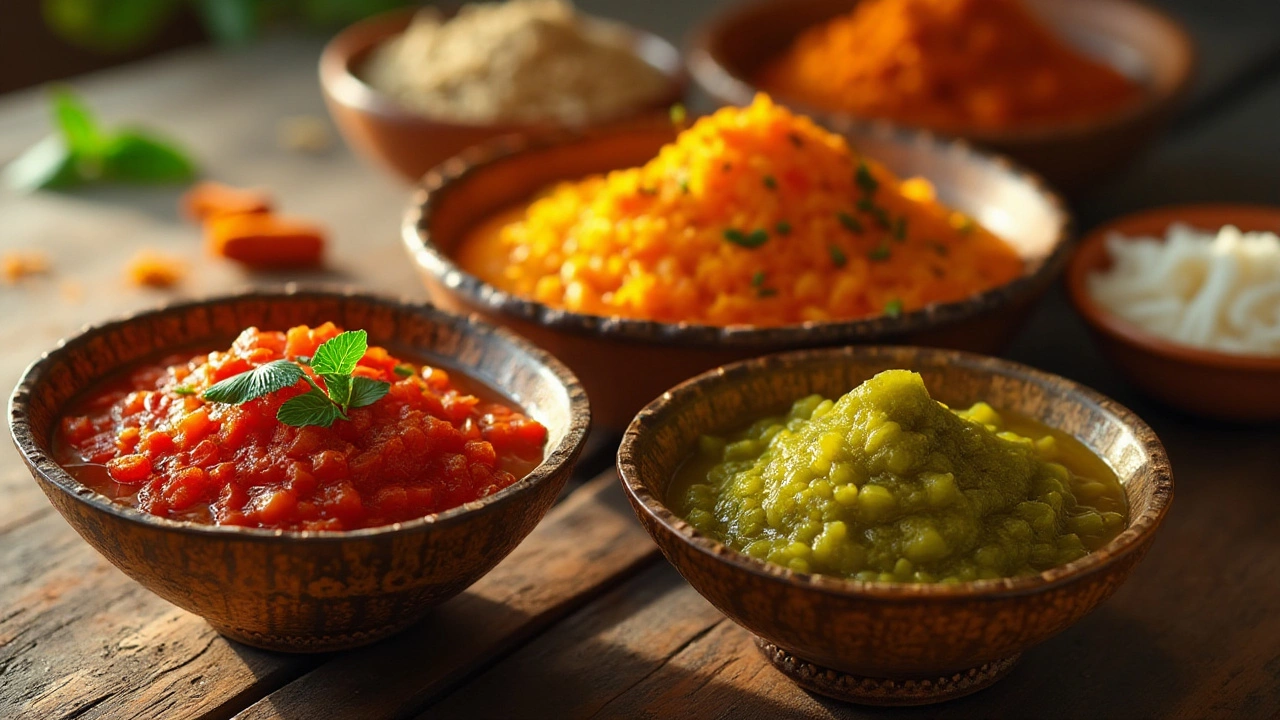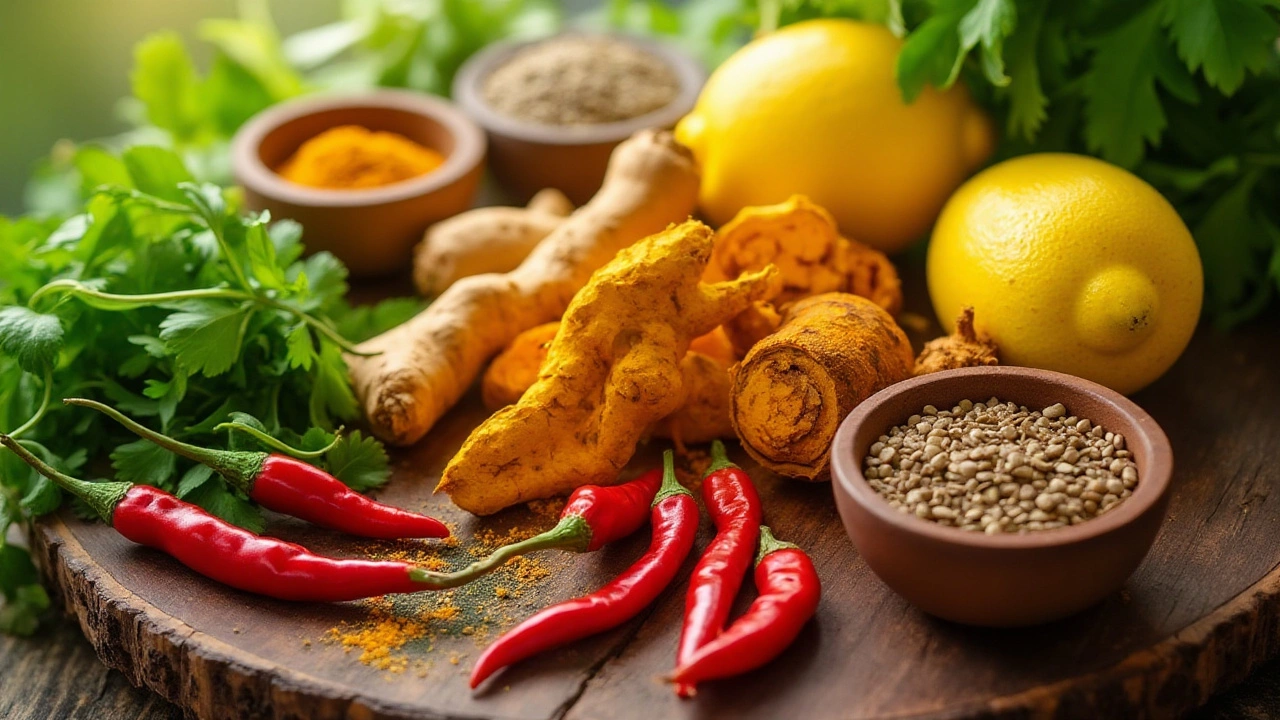Chutneys, a beloved tradition across various cultures, are known for their vibrant flavors and ability to enhance meals. Beyond their delicious taste, many wonder if these condiments also pack a health punch, particularly regarding inflammation. By examining the ingredients commonly found in chutneys, we can uncover the secrets that could potentially make them a beneficial addition to an anti-inflammatory diet.
Inflammation is the body's natural response to injury or infection, but chronic inflammation can lead to numerous health problems. This is where certain foods, like those used in chutneys, might come into play with their purported anti-inflammatory properties. From ginger to turmeric, let's explore what makes chutneys more than just a tasty complement, and how they might contribute to health and wellness.
- The Power of Ingredients
- Understanding Inflammation
- Chutney Varieties and Recipes
- Incorporating Chutney into Your Diet
The Power of Ingredients
Chutney, often viewed simply as a zesty condiment, boasts a complex tapestry of ingredients that play significant roles in its flavor and healthfulness. The inclusion of fresh herbs, vibrant spices, and ripe fruits or vegetables in chutneys contributes not only to their tantalizing taste but also to their potential anti-inflammatory benefits. Each ingredient, chosen carefully, dances in harmony with others to create something truly more than the sum of its parts. Ginger, a common fixture in many chutney recipes, is well-known for its powerful anti-inflammatory properties, thanks to compounds like gingerol. This wondrous rhizome adds spiciness and depth to chutneys while potentially aiding in reducing inflammation in the body.
Garlic, another staple seen across multiple chutney varieties, is renowned for its numerous health benefits. Rich in allicin, it is believed to contribute to decreasing inflammation and bolstering immune function. Turmeric, with its active compound curcumin, has long been studied for its remarkable ability to combat inflammation; its earthy essence can often be found in savory chutneys. Crucially, black pepper can be paired with turmeric to enhance the body’s absorption of curcumin, emphasizing how the right combination of ingredients can amplify health benefits.
Fruits frequently take on starring roles in many chutney recipes, offering both sweetness and nutritional value. For instance, mango (often used in traditional Indian chutney) contains quercetin, which may help reduce inflammation. Similarly, tomatoes, when used as a base, are packed with lycopene, another substance noted for its anti-inflammatory effects. Let’s not overlook apples, cranberries, or apricots, which also contain polyphenols that promote health by combating inflammation.
Spices and Herbs: Nature’s Phytochemical Powerhouses
Spices and herbs are pivotal not only for flavor but also for their dense concentration of vital phytochemicals. Cumin, coriander, and fennel seeds frequently make an appearance in chutney creations. These seeds offer not just an aromatic touch but also impede inflammatory markers, making them a cherished aspect of these relishes. Cilantro, rich in antioxidants and other beneficial compounds, often finds its way into green chutneys, offering both its distinct taste and potential to alleviate inflammation.
As Dr. Andrew Weil, a pioneer in integrative medicine, once expressed, "Spices are not just about flavor; they are a boon for our health, playing a pivotal role in the way food can heal or help maintain well-being."
In diving deep into what makes chutney an extraordinary condiment, the synergy between its ingredients reveals more than just culinary delight. It underscores a blend of traditional wisdom and modern nutritional science, highlighting how a humble side dish can become a mighty health ally. When crafting or choosing chutneys, being mindful of the ingredients can transform them from a mere accessory to a functional food that nurtures the body as much as it pleases the palate.

Understanding Inflammation
Inflammation is a fundamental process employed by your body as a defensive mechanism against what's perceived as harmful. It's a part of your immune response, reacting when you encounter challenges like infections, injuries, or exposure to toxins. While acute inflammation is beneficial in healing wounds and fighting off bacteria, the challenge arises when it becomes chronic. This prolonged inflammation can contribute to a variety of diseases and ailments, including arthritis, heart disease, and even some forms of cancer. Recognizing the shift from a protective mechanism to a contributor to disease is essential to adopting a diet that can help manage inflammation.
One pivotal factor in chronic inflammation is the role free radicals play. These unstable molecules cause oxidative stress, which damages cells over time. Antioxidants found in foods like fruits, vegetables, and perhaps ingredients in chutney can neutralize free radicals, reducing inflammation. Incorporating antioxidant-rich foods in your diet can, therefore, be a proactive way of combating chronic inflammation. But how do common chutney ingredients like turmeric, ginger, and garlic contribute to this endeavor? Each brings something unique to the table.
For example, turmeric contains curcumin, a compound known for its potent anti-inflammatory effects. According to Dr. Helen Crawley, a nutrition expert, "Curcumin can match the effectiveness of some anti-inflammatory drugs without the side effects." Similarly, ginger contains gingerol, recognized for its ability to mitigate inflammation. Garlic, too, is a storied performer in this area, attributed to its high allicin content. These ingredients not only elevate the flavor profile of your chutney but also contribute nutritionally. This could potentially transform homemade sauces into powerful allies against inflammation.
Ample research suggests that diet plays a significant role in managing inflammation. The Mediterranean diet, rich in anti-inflammatory foods such as olive oil, nuts, and vegetables, has been shown to reduce markers of inflammation. Including spices, like those found in chutney, can be a flavor-packed way to enhance this dietary approach. A spice-rich diet, filled with substances like curcumin, gingerol, and allicin, might not only elevate health outcomes but also your palate. Chutneys, thus, fit seamlessly into an overall strategy of dietary richness and wellness.
To grasp how much impact these ingredients have, let's examine some data:
| Ingredient | Active Compound | Inflammation Reduction (%) |
|---|---|---|
| Turmeric | Curcumin | 25% |
| Ginger | Gingerol | 15% |
| Garlic | Allicin | 20% |
These percentages are indicative of the potential reduction in inflammatory markers as found in some studies, illustrating why chutney, loaded with such ingredients, can be more than just flavorful. It's a tasty approach towards supporting your health from the inside out, making every meal a step toward a more balanced inflammatory response.

Chutney Varieties and Recipes
The world of chutney is as diverse as the cultures that enjoy them. These tantalizing condiments have countless variations, each offering its unique taste and potential health benefits. When delving into chutney varieties, one can start with the classic chutney types like mango, mint, and tamarind. Mango chutney, often sweet and spicy, is a delight that originated in South Asia. It's known for having rich textures and a harmony of flavors, blending the sweetness of ripe mangoes with the heat of red chili powder and the tangy notes of vinegar. The pungent aroma and sharp taste of mint chutney, on the other hand, make it an excellent palette cleanser and digestive aid, often served alongside Indian appetizers or entrees.
While the traditional chutneys hold a special place, modern spins on these classics have captured the imagination and taste buds of many. Avocado chutney, for example, gives creamy richness with a healthy twist due to the beneficial fats found in avocados. Beetroot chutney adds an earthy, sweet kick and a striking color. These contemporary selections often incorporate anti-inflammatory ingredients like ginger or turmeric, which have been celebrated for their health-enhancing properties. The creative fusion of flavors and nutrition makes these chutneys both delicious and potentially beneficial for reducing inflammation.
"Chutneys can enhance a meal not just gastronomically, but also nutritionally," says Chef Anjali Pathak, an expert on Indian cuisine. "With the right ingredients, chutneys can be a powerhouse of health benefits."
Preparing chutney at home is a rewarding experience, allowing control over the ingredients and their quality. For a basic mango chutney, the process begins with peeling and chopping ripe mangoes. They are then cooked with sugar, vinegar, and spices until they reach a jam-like consistency. Each ingredient plays a crucial role not just in flavor but in offering potential health perks. Vinegar is known for its probiotic properties, while spices can amplify the anti-inflammatory effects. The beauty of making your chutney lies in the flexibility to adjust the flavors to your preference, increasing or decreasing sweetness, acidity, or heat.
Steps to Make a Simple Mango Chutney
- Peel and dice ripe mangoes.
- Add mangoes, sugar, and vinegar to a pot.
- Incorporate spices such as red chili powder and grated ginger.
- Simmer the mixture until thickened.
- Cool and store in sterilized jars.

Incorporating Chutney into Your Diet
Incorporating chutney into your daily meals can be both a flavorful and health-conscious decision. To start, chutney complements a variety of dishes, from the traditional to the contemporary. Whether you are adding it to an Indian meal, a sandwich, or a cheese platter, its versatility is unmatched. When choosing the right chutney, consider the key ingredients known for their potential anti-inflammatory properties, such as ginger, turmeric, and garlic. These ingredients not only enhance the taste but could also provide health benefits. For example, turmeric, a staple in many chutney recipes, contains curcumin, which might help reduce inflammation.
"Spices and herbs used in chutneys are often packed with medicinal properties," notes Dr. Priya Jha, a nutrition expert. "Incorporating them into meals can be a simple yet effective way to leverage their health benefits."
For those new to chutneys, starting with a few basic recipes is a smart move. A classic mango chutney can add a sweet and tangy twist to grilled meats, while a cilantro and mint chutney can brighten up salads and act as a refreshing dip. Experimenting with different recipes allows you to discover flavors that align with your tastes. Moreover, homemade chutneys can be a healthier option, as you control the amount of sugar and preservatives. Batch-making your favorite chutney can also be a time-saver, letting you enjoy its benefits throughout the week. You can store these delectable concoctions in airtight jars in the fridge, ready to enhance any meal at a moment's notice.
Another exciting way to enjoy chutney is by incorporating it into more unconventional dishes. Try spreading it on your morning toast for a vibrant twist, or mix a spoonful into your hummus for a spicy kick. You can also use chutneys as a marinade, bathing proteins overnight for an infusion of flavor. Furthermore, top your tacos with a salsa-style chutney to elevate this classic dish with an exotic flair. The possibilities are endless, and the best part is that you can adjust flavors and experimentation to your liking. Such creativity not only makes meals more delightful but keeps them nutritious as well. To make it easier, here's a handy guide to pairing certain types of chutneys:
| Chutney Variety | Recommended Pairing |
|---|---|
| Mango Chutney | Grilled Chicken or Pork |
| Tamarind Chutney | Appetizer Platter |
| Coconut Chutney | South Indian Dishes |
| Coriander Mint Chutney | Samosas, Salads |
By considering the type of chutney to use and pairing it wisely, you can enhance the dining experience, unlock new culinary adventures, and potentially contribute to better health. As you explore these flavorful options, always remember moderation is key, especially when taking into account the sugar content in some chutney recipes. By doing so, you'll be able to enjoy the rich, striking flavors of chutneys while pursuing a balanced and anti-inflammatory diet. So, why not introduce chutney into your daily meal planning today?
